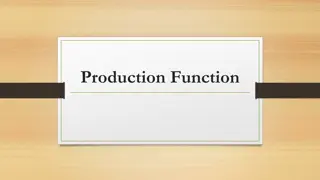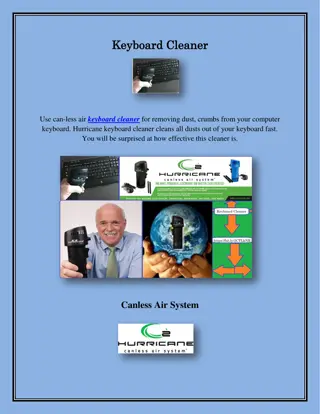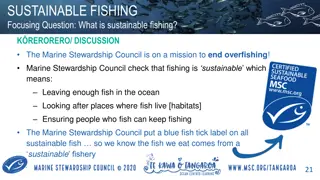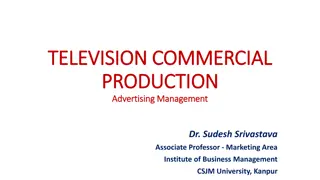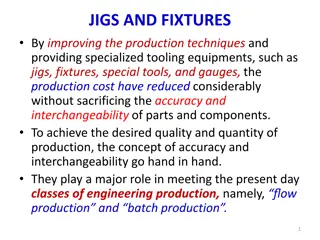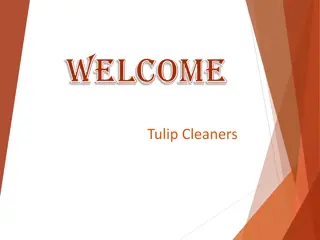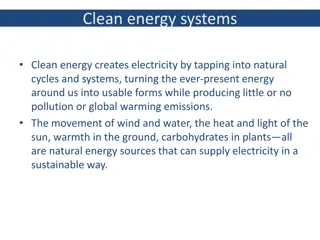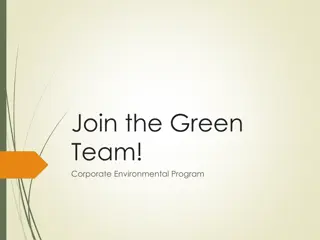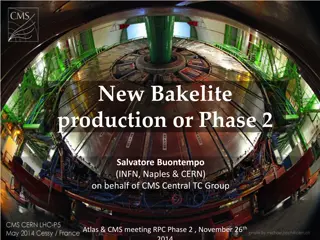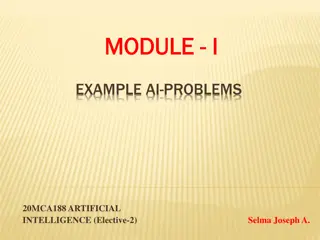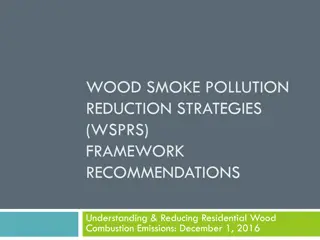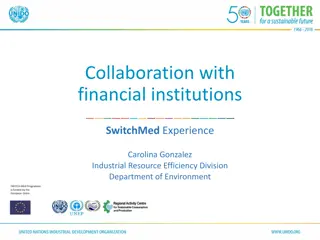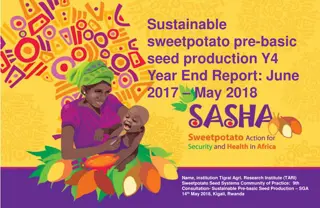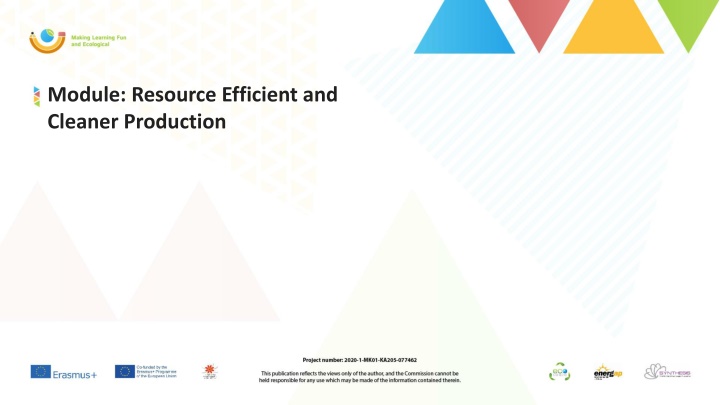
Resource Efficient and Cleaner Production: Sustainable Practices Explained
Resource efficient production involves utilizing Earth's resources judiciously, considering factors like resource usage, conversion processes, access, sustainability for future generations, and environmental impacts. It emphasizes a systemic approach that evaluates contributions towards sustainable development. Cleaner manufacturing strategies aim to protect the environment by enhancing efficiency and reducing risks.
Download Presentation

Please find below an Image/Link to download the presentation.
The content on the website is provided AS IS for your information and personal use only. It may not be sold, licensed, or shared on other websites without obtaining consent from the author. If you encounter any issues during the download, it is possible that the publisher has removed the file from their server.
You are allowed to download the files provided on this website for personal or commercial use, subject to the condition that they are used lawfully. All files are the property of their respective owners.
The content on the website is provided AS IS for your information and personal use only. It may not be sold, licensed, or shared on other websites without obtaining consent from the author.
E N D
Presentation Transcript
Module: Resource Efficient and Cleaner Production
Concept of correct usage of Earths resources (Resource Efficient) When it comes to deciding about the correct usage of Earth s resources, we should consider the following: 1. What we mean when we say resources, i.e., resources are all forms of matter (including water as separate category of resources) and/or energy that are included in some process of manufacturing, and with its transformation within that process, on the very output are some specific products and/or services that can be used again as resources in a new manufacturing process and/or serve as final products intended for satisfying the needs of the end users; 2. How much of these resources will be used; 3. Which processes would be involved for converting/transformation of these resources from one to another shape in order to get a final form in which they will be implemented; 4. Who exactly has access to these resources;
5. Are there enough of these resources to satisfy the needs of the next generations; 6. Will exploiting of these resources results in some change in the environment. It is important to understand that during evaluation of the contribution of a system, process, and similar, toward the sustainable development and/or evaluating its sustainability from a viewpoint of so-called pillar basis, as complete and suitable is the systemic approach. This approach means that every system (natural or anthropogenic) should be observed as a whole comprised of its composing elements (whether they are static or dynamic), in its spatial and time limits. Thus, in the previously defined time and spatial limits in that system, the static and/or dynamic components, together with their correspondings (relations) should be observed through the prism of ensuring quality that is/was previously set to be reached through/existing, working and/or exploiting of that system.
Coefficient of efficiency of transformation of the transformation Limits of the system in space and time
Term of a concept for historical review i.e., more efficient in terms of resources and cleaner manufacturing: Back in 1990, as answer to the rapid increase of expenses for preventing or overcoming the pollution, the United Nations Environment Program (UNEP) starts working on alternative approaches for pollution prevention. As a result to this, UNEP defines the term cleaner manufacturing and suitable strategy for cleaner manufacturing such as unobstructed implementation of the integrated strategy for protection of the environment, over processes, products and services (covered manufacturing as well), with the goal of increasing the efficiency and reducing the risks for humankind and environment too.
With the development of acknowledgements and taking into consideration the awareness that resources of the Earth are limited, the term cleaner production of 2010, is replaced with the term concept of more efficiency regarding resources and cleaner production, and as such it predicts unobstructed implementation of integrated and preventive strategies over processes, products and services. Modified in such a way, the new term belongs in the broadened family of terms, that in turn are of the areas of pollution prevention, and efficiency in using of resources. The image below presents a scheme for this definition of the concept for more efficient for more efficient regarding resources and cleaner production. To the environment Processes Continuous Strategy for protection of the environment Risk reducing Products Preventive Services For the people Integrated
The holistic approach of the concept of more efficient in terms of resources and cleaner manufacturing promoted by UNEP and UNIDO is comprised of the prevention aspect of the strategy that should be implemented over the overall manufacturing cycle (as to the process itself, so to the products too) with the goal of: Reaching better productivity through ensuring of more efficient usage of materials, energy and water; Promoting of better performance of manufacturing from aspect of the environment through reducing of the generated waste and emissions in air and water;
Reducing of the influence over the environment stemming from the processes, products, and/or services in the course of their lifecycle through thinking ahead, projecting and manufacturing of products that are efficient cost-wise, but also environment-friendly; Applied in the manufacturing concepts, the RECP concept includes a rational usage of raw materials, water, energy, replacement of dangerous materials with ecologically accepted ones, as well as reducing of the amounts and toxicity of emissions and waste in water, air, and earth;
Gathering of raw materials Outputs: Inputs: Producing, processing and formulation PRODUCTS THAT COULD BE USED ENERGY Distribution and transport EMISSIONS IN WATER (EFFLUENTS) WATER Usage, reusing, maintenance MATERIALS EMISSIONS IN AIR Recycling SOLID WASTE MATERIALS OTHER REALISES THE ENVIRONMENT Waste management
Applied to the products, the RECR concept is a strategy directed toward reducing of all negative influences over people and the environment during the course of a lifecycle of the product, from receiving of the products to the final storage of the long-term products. In that way, the RECR concept can be evaluated as a self-help mechanism because: The basic idea of the concept implementation (RECP) over a project is help for self-help; The participants in the project are those that know the reviewed enterprise the best, and that know how is important for a successful project realization. The knowledges that would stem from outside consultants will be of help for creating suitable solutions in terms of realization of the RECP concept. According to this concept, priority in the pyramid of treatment is the prevention, minimizing and recycling of waste (right side).
Prevent Minimize Prevent Minimize Recycle Treat Recycle Treat Remove Remove
It is needed to emphasize that the implementation of RECP focuses on the importance and awareness of the environment protection, without ignoring the economic and manufacturing aspects within the entity (company, enterprise, public services, etc.) that are reviewed. Even more, the quality of products and services that are secured by the reviewed entity should not/must not be reduced due to usage of RECP. Namely, RECP promoted that it is possible to implement the principles of protection of the environment parallel to knowing the economic aspects/benefits. The net-effect of the implementation of RECP concept is enabling of better competitiveness and better approach to the international market, especially for entities situated in countries of development and economies in transitions. An additional benefit is the change of thinking, behaving, discipline, because the RECR concept needs habit changing, as well as changes in behavior, practicing mindful managing from a viewpoint of protection to the environment and promotion of the change in technologies in terms of implementation of the latest accessible technologies and techniques.
Taking into consideration the previous, the strategy which is promoted with the RECP concept, is the win-win strategy of mutual win, since at the same time it is concerned with protection of the environment, workers that are part of the manufacturing process and end consumers too, and the efficiency of manufacturing is improved, but also its profitability and competition aspect. Even more, it can be said that the concept RECP is a tool 4-in-1, i.e., RECP concept is: 1. Management tool for processes, products and services 2. Economic tool, 3. Tool for protection of the environment and 4. Tool for Quality Assessment and Quality Control
Beside the above-mentioned, there are many other reasons, motivations and benefits for which a certain entity would decide to implement the RECP concept. Some of the could be the following: 1. Fulfilling of legal requirements and regulations; 2. Pollution reducing; 3. Increasing of productivity; 4. Reducing of costs and/or an additional financial benefit (due to reduced amounts of input resources and/or waste and emissions in water and air and/or due to recycling and repeated usage of some resources); 5. Improved health and safety during working;
6. Reducing of risks; 7. Increasing of quality and consistency 8. Implementation of new technologies; 9. Increased motivation of employees (staff); 10 Promoting and branding of the entity as environment-friendly
The scope of usability of the concept of more efficiency regarding resources and cleaner production (RECP) is not limited to just the industry and/or manufacturing, but it can also be implemented better in the service sector, as well as the programs for development of the local government The activities linked to usage of the concept of Resource Efficient and Cleaner Production must not equate to usage of expensive and complicated technologies, techniques and methods. Often, just by changing the behavior and habits, can be reached initial good results in terms of reducing of resources, waste materials, through unchanged quality of the products, processes and services.
The usage scope of the RECP concept within one entity (company, municipality, region, etc.) is broad and refers to: - Technologies - Processes - Materials - Products - Employees - Partners http://studyinspb.ru/fr/inside-the-industrial-ecology-and-cleaner-production-masters-program-at-itmo- university/
Look at the video: https://www.youtube.com/watch?v=9u1t285wnJg
Sources used: dr. Anita Grozdanov, regular professor; manual for implementing of a training for sustainability advisor, Skopje 2018 https://www.un.org/sustainabledevelopment/blog/2015/09/fostering-sustainable-economic- growth-transformation-and-promoting-sustainable-consumption-and-production/ https://ecologic.mk/the-manual-for-development-%d0%b0-training-advisor-of-sustainable- development/


